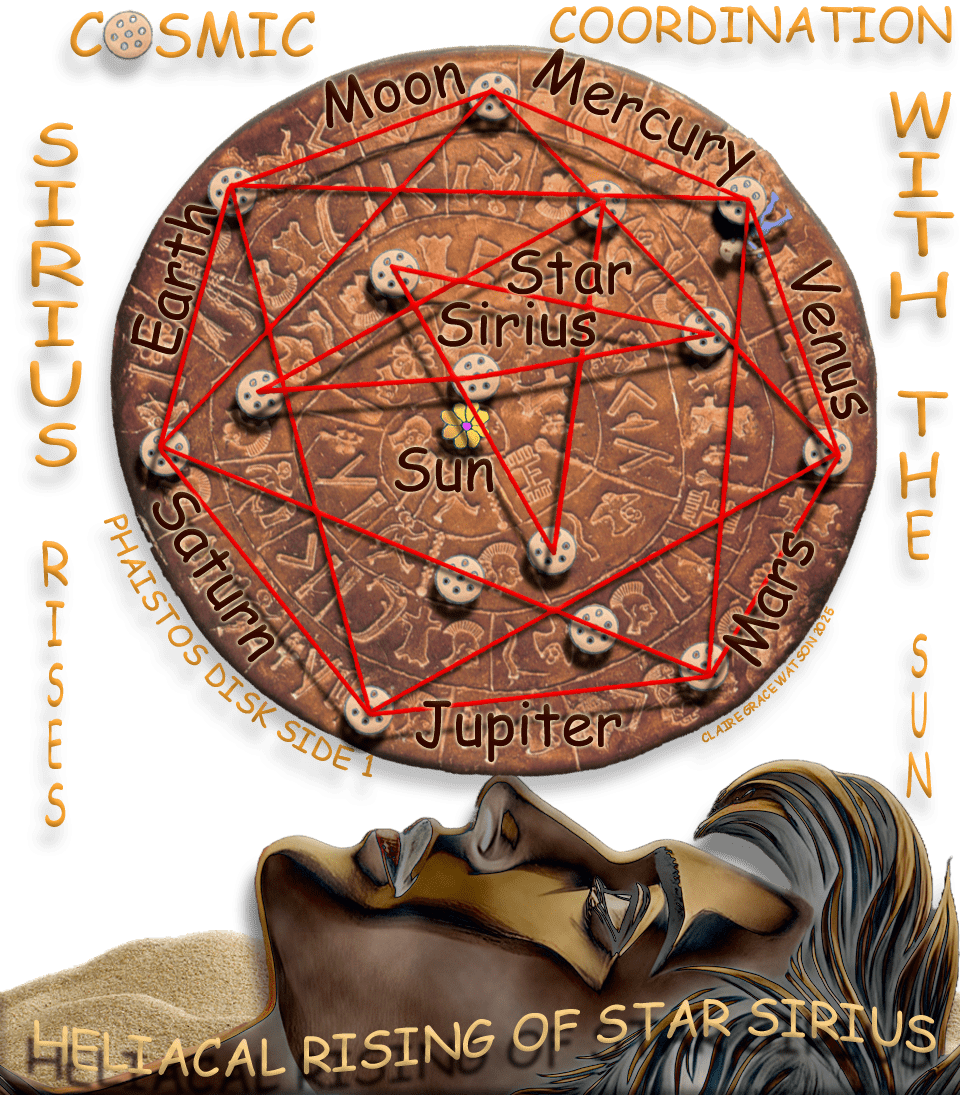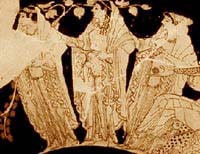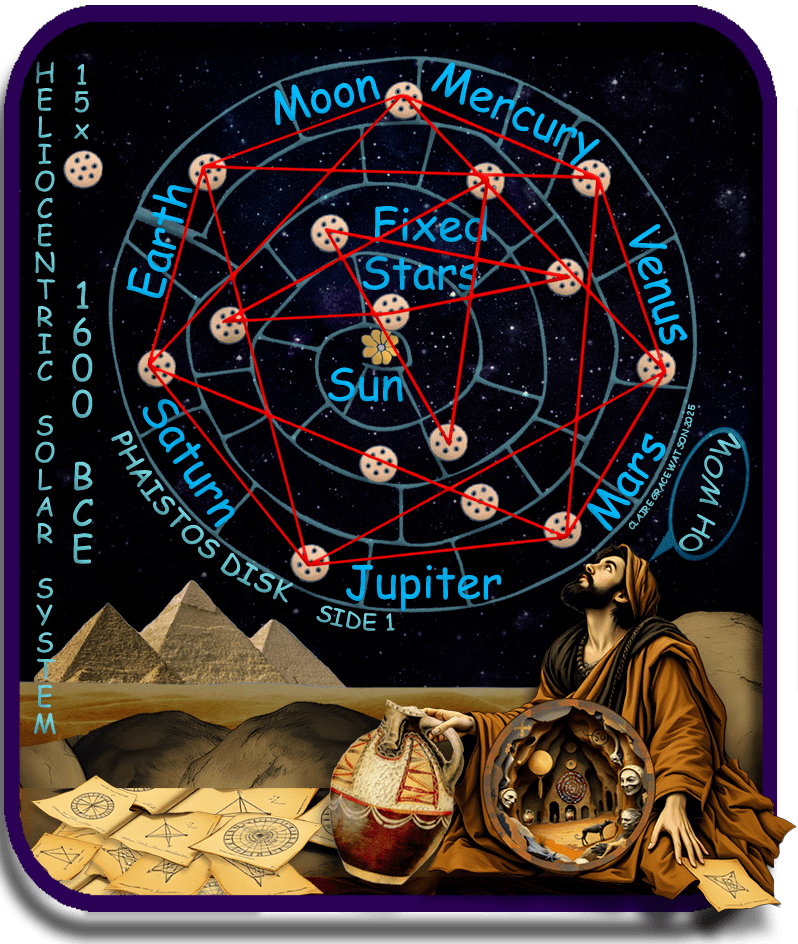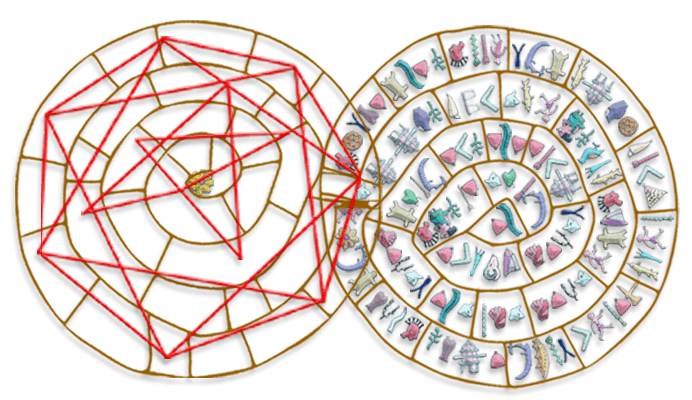
In addition to hidden patterns, the Phaistos Disk may preserve an ancient calendar with multiple uses. The Disk might be a zodiac stellar calendar based on star groups. Star groups might be arranged in groups of 12,
along the outer edge in the same location as the lunar months. These might be the 12 constellations we are familiar with today that are generally accepted as identified by Minoan
Crete. 18 more spiral out from the center of Side 1 and Side 2, for a total of 36 groups or decans, each one rising above the dawn
horizon for 10 days, totaling 360 days. The star groups spiral into the center as they begin their move into the underworld of Tartarus/Hades
(go below the horizon) for 70 days/signs before they appear again.
18 star groups spiral into the center (18 line segments of the inner spirals) as they move into the underworld of Tartarus/Hades (go below the horizon) for 70 days before they reappear. 70 is the exact number of pictographs, beginning at the crossover from Side 1 to Side 2, countingfrom the first pictograph met with in spiral 4, the dog, "dog star," an ancient symbol for Sirius. Therefore, each one of these pictographs represents a day in which the star Sirius, seen rising with the sun on Side 1, has now disappeared from the sky on Side 2. Heliacal rising of Sirius will occur again at the flower on Side 1 in an infinite cycle, as represented by the infinity symbol created when the two sides of the Disk are joined together at the matching, connecting line segments.
Observation of the
movement of star groups would let the Minoans tell time at night because the decans would rise 40 minutes later each night. When reckoning time at
night, only 12 decans (and annual divisions) were used (our signs of the zodiac), delineated by the 12 line segments along the edge of the Disk, although 18 were taken into account, those delineated in the center of the
Disk by the 18 line segments. With the addition of a 10 day intercalary month every two years, a 365-night stellar year can be accounted for.
Set these calendars to the first sighting of Sirius each year to keep them current. The Sothic (Sirius) year lasted from one
sighting of Sirius in the dawn of a new year until the next year on the same day. With these calendars working together, and with Oceanus, the World Ocean encircling the world (the wave
spirals below) and connecting these calendars together in a neverending wave spiral, infinity is accounted for, represented by the infinity symbol created by interlocking both sides of the Disk.
Long after the Phaistos Disk was created, the Greeks gave the name Helios to the god of the measurement of time. He had several sister goddesses called Horae, goddesses of the cycles of Time who reigned over the revolution of the constellations by which the passing seasons were measured. The Horae were honored by farmers, who would hoe the ground, plant and tend their crops according to
the location of the stars in the skies. (The Horae, right, hold pomegranates/stars, and left on the Disk.) Because the Horae surrounded the throne of Helios, this method of
timekeeping is a heliocentric horae-scope or horoscope, meaning to observe time or the seasons.
This method of keeping "star" time might point to the Sothic calendar, a wide-spread
Egyptian method of keeping time by tracking the star Sirius instead of the sun. The matching shield pictographs on side 1 when connected reveal a pentagram inside a heptagon, perhaps the star Sirius surrounded by the seven planets. This might indicate the Minoan use of a Sothic calendar.
In the Egyptian sense, it is SIRIUS the Dog-Star, the Star or Isis-Sothis. Around it are the Stars of the Seven Planets each with its seven-fold counterchanged operation. (Israel Regardie, The Golden Dawn, re: pentagram inside heptagon design in mysticism)
Mathematics is apparent on the Disk, and we can discover Mediterranean Bronze Age concepts of mathematical symmetry just by counting the pictographs, the spirals, and the line segments. The Phaistos Disk is terracotta pottery, about 6-1/4" diameter, a bit larger than a CD, with 2 inscribed sides and 2 spirals per side, each spiral with 5 rings (10). The spirals are divided into 60 line segments (30 Side 1, 30 Side 2). The outside spirals have 12 line segments (24 outside); inside spirals have 18 (36 inside). Divided among the line segments and etched into the the Disk are 48 unique miniature pictographs, most of them repeated to create 240 pictographs. 37 are created to appear identical and are repeated various times. 11 are unrepeated.
If the two sides of the Phaistos Disk have application as Minoan integrated calendars, taken together they might be a
Lunisolar calendar with 12 months and, every two years, the periodic intercalation of a 13th month, the interlinking line segments.
Side 1, the solar calendar, keeps track of the three seasons, each of four months duration, along the 12 line segments of the outer edge.
A count of the daylight hours or divisions of each day could also be kept on this side of the Disk, counting 12 divisions/hours along the
outside edge with the 12 months and the seasons of the year.
Side 2, the lunar calendar, keeps time in lunar months (moonths), a moonth being the time between the four phases of
the moon - new, waxing, full and waning. The lunar calendar has 12 moonths of 30 days for a 360-day year. The first month and new year might
begin in the summer on the heliacal rising of star Sirius in 1600 BCE, approximately the equivalent of our July 1. Alternately, the Minoans may
have had 30 months of 12 days – the 30 line segments each side, 12 of them on the outside spiral. Every two years the 13th month would occur and
it would be only 2 days shorter than the others.
The combined Lunisolar calendar might have worked this way; one month solar, one month lunar, moving from side to
side of the Disk, until 24 months had passed, at which time the intercalary or 13th month would begin the biennial festival of Dionysus in
Minoan Crete in which the drama of his life was re-enacted.
When did the first logic of infinity occur to us collectively and when was it first represented as a horizontal figure 8? Could it have been during the Minoan civilization? The integrated calendars may not have been intended to work this way, but if we wanted to keep time in these different ways we could if we
had the Phaistos Disk. And we could even have a Sothic calendar.
Sothic is the Greek word for Sirius, which the Egyptians called Sopdet or Sopdu. A Minoan
calendar/Phaistos Disk would be unique in that it may have solved the problem of keeping accurate time when tracking star Sirius.
All Sothic calendars were known to have 12 months of 30 days. Some Sothic calendars may have had 30 months of 12 days.
Both presented the Egyptian timekeepers with a problem -- a year of 360 days -- so they had to add 5 days at the end of the year to have a 365-day year so
that the calendar would work right.
The Egyptians had a whole mythology that went with these 5 extra days/gods, which were festival days in Egypt and perhaps Crete,
when the birth of these gods was celebrated. With the extra 5 days added, the Egyptian Sothic calendar would start again the following year
on or about the same important day -- the heliacal rising of Sirius -- the day the star first rises with the sun. But the Sothic cycle was 1468 years because that is how long it takes for the calendar to recoup that day that was lost every 4 years from having a 365 day year.
The Phaistos Disk may be a Sothic calendar that keeps accurate star time, and it
may be the only physical one in existence. There may be something unique about this Sothic calendar. Instead of having 12 months of 30 days, it
may have alternating months of 30 and 31 days, (counting the connecting line segment as a day of the month rather than an intercalary month) more
like our calendar than like the Egyptian calendar. Around the outside edge of the Disk are the 12 solar and the 12 lunar months. The solar months have 31 days and the lunar months have 30 days. The 2-sided Disk/calendar
represents a two-year period, at the end of which was held the festival of Dionysus in which his life was celebrated.
This method of keeping time would be incredible if you consider what is known about Sothic calendars. It means that the Minoans may
have figured out how to adjust a Sothic calendar so it kept proper star time and avoided the "Sothic cycle" of 1468 years.
When you look at our calendar you see something odd about it. The months don't alternate 30 and 31 days
every time, and February has only 28 days. Then, every four years we add a day to make up for the fact that our year is really 365 and 1/4 days,
and that ends our cycle. Our calendar is only off by a 1/4 of a day each year and we are
unaffected by that as long as we correct periodically.
The Minoans may have taken exactly the same approach. The difference is, while the Egyptians had years of 360 days and we have years
of 365 days, the Minoans may have had years of 366 days. Rather than add 5 days at the end of the year and then have a calendar that rights itself
every 1468 years, the Minoans may have had alternate months of 30 and 31 days. Then, they subtracted a day at the end of every two years, and that kept them
within a 1/2 day of accuracy and ended their cycle. Instead of adding 5 festival days at the
end of the year, like the Egyptians and their civil calendar, they may have celebrated them along with the Egyptians as festival days that occurred for them at the beginning of their
year with the heliacal rising of Sirius. Then, every 2 years they held their own festival of Dionysus on the "subtracted" day, a day that didn't exist at all because it wasn't on their calendar - perfect for a wild, Dionysian bacchanal!
By their subtraction method of timekeeping, the Minoan calendar would be simple and correct. If it really worked this way it would have given them a huge
advantage over the rest of the Aegean world and might explain in part their fantastic civilization. Their calendar would always have been a little ahead
instead of a lot behind. Additional to their world view might have been the enlightened idea that time and the stars are dieties we can shape, using our imagination and the tools of geometry, to become more than mere subjects of them.



 Minoan Lunisolar CalendarMinoan Sothic Calendar
Minoan Lunisolar CalendarMinoan Sothic Calendar

![]()
 Sirius rose with the sun on about the same day every year, July 19th, the sun perhaps represented by the 8-petaled "Flower" at the center of Side 1. Just like we add one day in February every leap year to
make our calendar and our sun work in conjunction, the Egyptians added 5 days at the end of their year and tracked the movement of a star
rather than the sun. The star's movement is so close to that of the sun that the star calendar worked the same as a sun calendar. One is a
lunar calendar and the other is a solar calendar.
Sirius rose with the sun on about the same day every year, July 19th, the sun perhaps represented by the 8-petaled "Flower" at the center of Side 1. Just like we add one day in February every leap year to
make our calendar and our sun work in conjunction, the Egyptians added 5 days at the end of their year and tracked the movement of a star
rather than the sun. The star's movement is so close to that of the sun that the star calendar worked the same as a sun calendar. One is a
lunar calendar and the other is a solar calendar.
![]()
![]() Just as night follows day, night perhaps represented by the "Star" at the center of Side 2, the Egyptians and perhaps the Minoans had calendars with
solar months and lunar months. Before electricity and without bright lights to obscure the night sky, our relationship with it was much more intimate than it is today.
Minoan 366-Day YearPagemapBookmap
Just as night follows day, night perhaps represented by the "Star" at the center of Side 2, the Egyptians and perhaps the Minoans had calendars with
solar months and lunar months. Before electricity and without bright lights to obscure the night sky, our relationship with it was much more intimate than it is today.
Minoan 366-Day YearPagemapBookmap![]()
 Copyright Notice - Disk of the World - Text and images copyrighted March 21, 1993-2025, Claire Grace Watson, B.A., M.S.T., U.S. Copyright and under the Digital Millennium Copyright Act of 1998, All rights reserved. No part of this web page may be reproduced or transmitted in any form or by any means without written permission from the author, except for the inclusion of brief quotations in a review.
Copyright Notice - Disk of the World - Text and images copyrighted March 21, 1993-2025, Claire Grace Watson, B.A., M.S.T., U.S. Copyright and under the Digital Millennium Copyright Act of 1998, All rights reserved. No part of this web page may be reproduced or transmitted in any form or by any means without written permission from the author, except for the inclusion of brief quotations in a review.